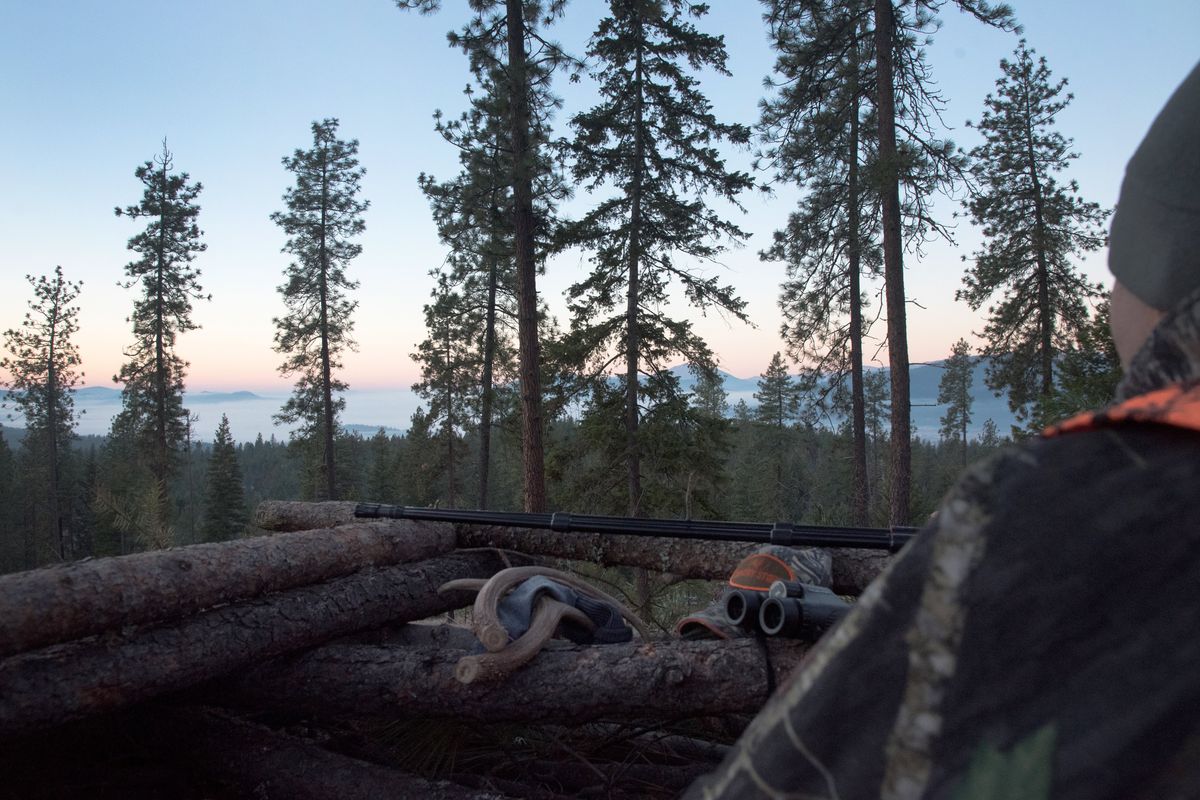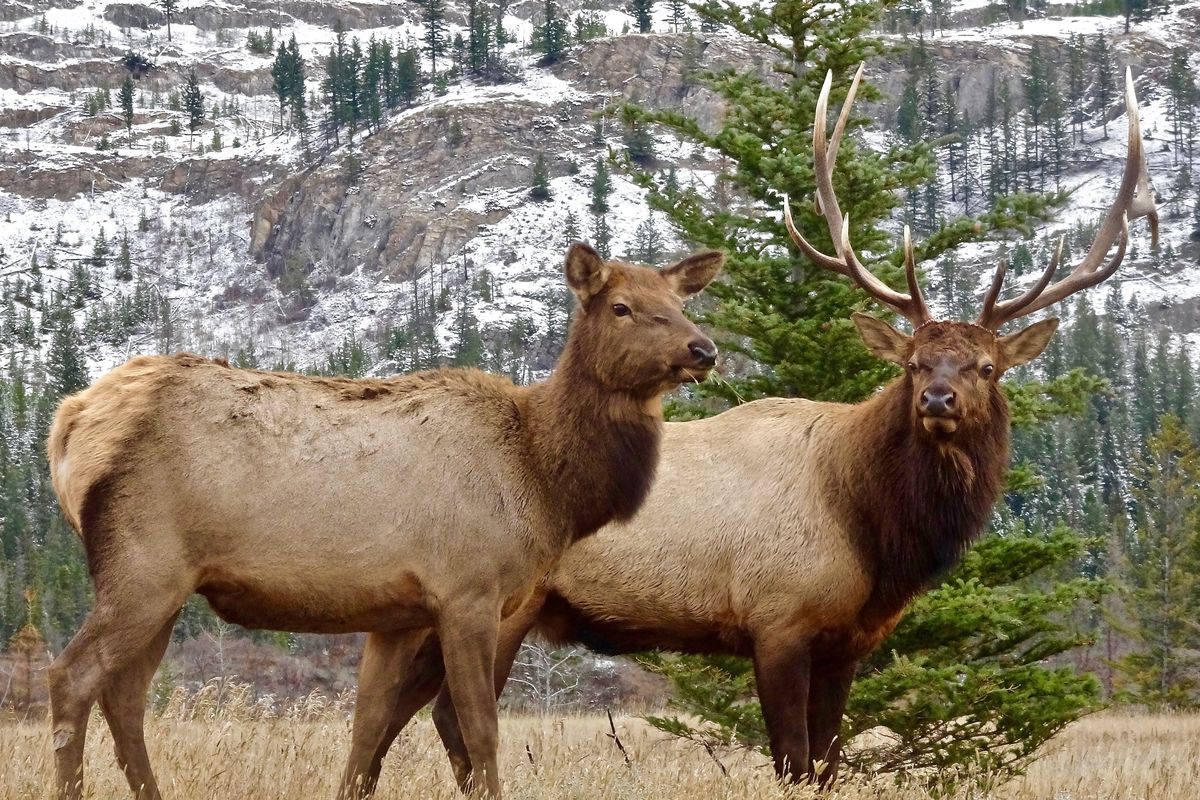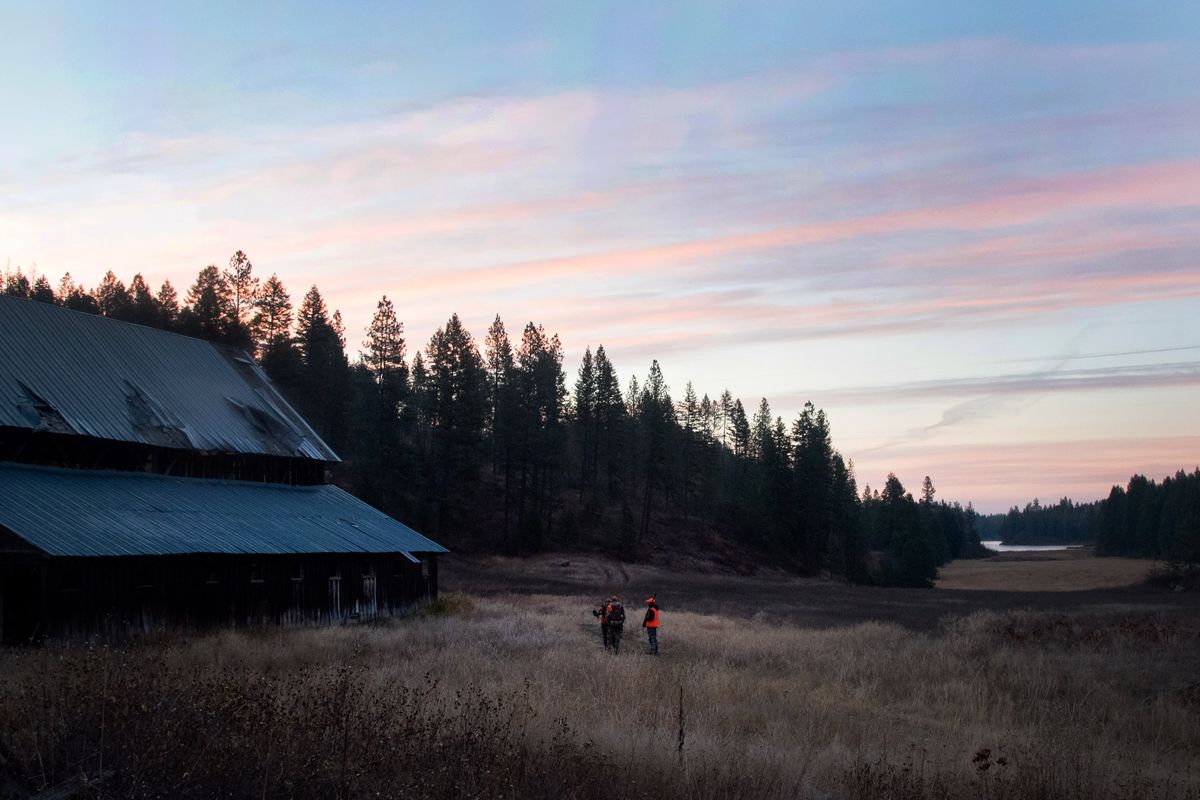S-R Hunting Outlook 2021: Fires, drought pose challenges for Washington big game hunters, opportunity remains
Three hunters confer on a strategy during autumn 2018. (Eli Francovich/The Spokesman-Review)Buy a print of this photo
Big game hunters in Eastern Washington face a host of uncertainties this year, including the lingering impacts of a drought, forest fires and the outbreak of two wildlife diseases.
Biologists with the Washington Department of Fish and Wildlife say there will still be opportunity to fill a tag. Plus, the crowds will likely be smaller this year, according to early license sale data. In 2020, nearly 10,000 more hunters took to the field than in 2019.
Wildlife officials expect those numbers to drop back to normal.
DistrictsEastern Washington is comprised of three “districts” within Region 1 of Washington’s game management system.
District 1 (Ferry, Pend Oreille, Stevens counties) is known for its white-tailed deer, moose and turkey hunting opportunities. Quality hunting opportunities also exist for other game species, including mule deer, black bear, forest grouse and cougar.
District 2 (Lincoln, Spokane, Whitman) is known for its deer hunting opportunities, including white-tailed deer in Spokane and Palouse agricultural lands and mule deer in channeled scablands and breaks of the Snake River. Quality hunting opportunities also exist for other game species, including pheasant and elk, if hunters have secured access to private lands. Moose and bighorn sheep hunters can enjoy quality hunts if they are selected for special permit hunts.
District 3 (Asotin, Columbia, Garfield, Walla Walla) is known for its elk hunting opportunities in the Blue Mountains and mule deer hunting opportunities in grassland/agricultural game management units. Hunting opportunities also exist for other game species, including white-tailed deer, black bear, chukar, turkey and pheasant.
Deer
District 1: Deer hunting opportunities in District 1 vary from fair to excellent, depending on the GMU. The best opportunities to harvest a mule deer in District 1 generally occur in GMUs 101 (Sherman) and 121 (Huckleberry). All GMUs within the district offer good opportunities to harvest a white-tailed deer. Mule deer are common in some high-elevation locations, particularly in Ferry County (GMU 101), but District 1 is not known for its mule deer opportunity.
One important rule change : In 2021, hunters of any user group or weapon type will not be able to harvest a doe, according to WDFW regulations.
For public land hunters, District 1 can pose a challenge as the best GMUs see lots of hunter pressure.
For example, in 2020, GMU 108 had the highest hunter-success rate at 32%. There were about three hunters, however, for every square mile on GMU 108.
The least-popular GMU was 113 with 1.9 hunters per square mile, but the hunter-success rate was 16%.
Still, opportunity remains. According to the agencies’ survey, whitetail and mule deer populations seem to be stable throughout District 1.
District 2: Overall, the white-tailed deer population is down in District 2 due to a series of events starting with the drought and bluetongue virus outbreak of 2015 that lasted well into October and had deer dying in Region 1 from Canada to Oregon. The relatively mild winter of 2015-16 helped a little, as did more normal precipitation that spring and summer, but the winter of 2016-17 was one the hardest in the past 10 years and decreased overwinter fawn survival. The population got a break in 2017 and started showing signs of recovery, but the winter of 2018-19 was another difficult winter (though not as bad as 2016), and there was a small outbreak of epizootic hemorrhagic disease in north Lincoln and northwest Spokane counties. The winters of 2019-20 and 2020-21 were mild, which should help the white-tailed deer population start to rebound. The lack of precipitation this spring and summer does not bode well for white-tailed deer.
Overall, mule deer herds are near their long-term averages. The mule deer populations suffered losses due to the same series of events noted above, but mule deer do not typically die from bluetongue and epizootic hemorrhagic disease, and the snows left the basin a bit sooner than in the northeast. The lack of precipitation and the likelihood of continuing drought will hurt mule deer and especially fawn survival and recruitment.
The reduced recruitment will likely not impact this year’s harvest but will be felt in the 2022 season.
In general, the best opportunities to harvest a white-tailed deer in District 2 occur in GMUs 124 and 127. The best opportunities to harvest a mule deer in District 2 occur in GMUs 136, 139 and 142. The terrain in GMUs 136–142 is better suited for muzzleloader and modern firearm.
There is a 3-point minimum antler point regulation in GMUs 127–142 for white-tailed deer, and the late white-tailed deer season in GMUs 127–142 is by permit only (the Palouse Special Permit Hunt) as of 2006. Hunter success over the past 10 years is, on average, higher for the Palouse hunt (43% versus 30% in the general season), with 5-plus-point bucks making up, on average, a greater percentage of the kill (37% versus 28% in the general season). There are 650 permits offered for the Palouse hunt.
District 3: Large wildfires in southeast Washington will impact hunting access, and success in District 3 and biologists recommend checking the most recent fire information and public land closure information from the Umatilla National Forest and WDFW. As of Sept. 9, the National Forest had reopened most of its lands within the Lick Creek fire area.
News to be aware of: Deer Area 1040 (4-0 Ranch Wildlife Area) has been eliminated and is open to general season deer and elk hunting under same regulations as GMU 172. Deer Area 1021 has been eliminated. This area was originally created to control resident deer in the area around Clarkston. Radio-collaring studies showed that it was likely many of the harvested deer were only using the Deer Area for winter range and were not resident deer causing damage issues. Any Deer permits were added for youth in selected GMUs.
Elk
District 1: Traditionally elk hunters in District 1 face an uphill struggle, and 2021 won’t be any different. The mountainous and forested landscape typical of District 1 makes hunting and surveying elk difficult. As of 2021, WDFW biologists haven’t surveyed elk in District 1, relying instead on hunter-harvest reports. Since 2009, hunters have killed between 200 and 300 elk in District 1 each year.
If you’re up to the challenge, WDFW biologists say the best elk hunting opportunities occur in GMUs associated with the Pend Oreille subherd area, which includes GMUs 113 (Selkirk), 117 (49 Degrees North), and 111 (Aladdin). Elk hunter numbers in the Colville District have increased over the past several years with hunter participation and harvest well dispersed across the Colville District through all three hunting methods. Hunting elk successfully within District 1 is no small challenge, according to agency biologists.
District 2: All elk in District 2 are Rocky Mountain elk and belong to the Spokane subherd of the Selkirk elk herd. The Selkirk herd originated in Pend Oreille County and has expanded its range over the past 40 years. As elk habitat in District 2 continues to be lost to agricultural conversion and urban sprawl, WDFW’s goal is to maintain the population at its current level (roughly 1,000–1,500 elk) while limiting agricultural damage and conflict within exurban areas. Consequently, an “any elk” harvest is offered for the general season in all GMUs. Elk in this herd can be highly mobile and difficult to locate, so learning their behavior and gaining access to numerous private lands will greatly increase your chance of success.
The terrain in GMUs 136–142 is better suited for muzzleloader and modern firearm, with open landscapes predominated by shrub steppe, scablands and dryland farming.
The majority of the district’s elk harvest (25-50%) is usually in GMU 130, though a high proportion consistently occurs in GMUs 124 and 127. Hunters who gain access to private lands in GMUs 127 and 130 have often had the highest success, though success in GMUs 136 and 139 has been higher the past couple of years. In GMU 130, hunters likely benefit from animals moving on and off Turnbull National Wildlife Refuge during the season.
District 3: Known for its elk hunting, most hunters heading to the Blue Mountains have been doing so for years. New hunters to this area will have to consider several options, such as weapon type, private land access versus public land, the difficulty of hunt desired (wilderness versus landscapes with roads), and, as archery hunters, whether the availability of antlerless opportunity is important. In 2021, wildfire activity will be an important consideration on where to hunt. As of Sept. 9, most public lands on the Umatilla National Forest had reopened.
Throughout District 3, the harvest of branched-bulls is regulated through the permit system. All GMUs in District 3 are managed for quality hunting, except GMUs 145, 186 and some hunts in 149. The drawing of these tags can be difficult, and many hunters invest years before successfully obtaining a permit. Once a permit is obtained, district biologists are available to provide information on where to hunt within a GMU.
Biologists in District 3 conduct an annual helicopter survey within the core elk areas to estimate the population size after winter. This spring, survey efforts resulted in a population estimate of 3,600 elk.
Surveys are conducted along the state line of Oregon and within the state, resulting in approximately 500-600 elk being classified that likely are not available for harvest in Washington during the fall.
The average five-year population estimate prior to 2020 was 4,830 elk, which is 25% higher than the 2021 estimate. The 2021 surveys documented a calf ratio of 22.0 calves per 100 cows and a bull ratio of 24.6 bulls per 100 cows.
Bear
Washington is divided into nine Black Bear Management Units (BBMUs).
District 1: Black bears occur throughout District 1, but population densities vary among GMUs. The best opportunities to harvest a bear likely occur in GMUs 101 (Sherman) and 117 (49 Degrees North), mainly on account of abundant public land that is open to hunting. Most hunters don’t target black bears specifically, instead hunting them opportunistically. Since 2004, hunter success in District 1 GMUs has varied from 4% to 18%. The success rate is likely higher for hunters who specifically hunt black bears versus those who buy a bear tag just in case they see one while deer or elk hunting.
In 2019, biologists conducted a survey to estimate black bear density in GMU 117. Density was found to be 31 bears/38 square miles. Black bear populations are believed to be stable in District 1.
Note: Black bear hunters in District 1 MUST complete WDFW’s online bear identification test each year and carry proof they passed it. To prep for and take the test in the Bear Identification Program, visit wdfw.wa.gov/hunting/requirements/bear-identification-testing.
District 2: Bear harvest in District 2 is substantially lower than in the rest of the Northeastern BBMU, likely due to habitat and hunter access limitations.
Most of the harvest usually occurs in GMUs 124 and 127. Although the Columbia Basin BBMU is not thought to support resident black bear populations due to lack of forested habitat, GMU 133 has averaged six bears per year over the past 10 years. Harvest in the other GMUs in the Basin (136-142) is low or nonexistent and would not be worthwhile to hunt for this species.
District 3: Black bears occur mainly in the foothills and forested areas of District 3, but population densities vary among GMUs. The highest densities of bears occur in GMUs 154 (Blue Creek) and 162 (Dayton). District 3 consists of GMUs that are part of the Blue Mountains Black Bear Management Unit 8 (BBMU 8). As in other areas, most bear hunting in District 3 is opportunistic. Since 2001, hunter success in District 3 has averaged just 6% and has never been higher than 9%.
Turkey
Hunters who harvested two birds in Eastern Washington during the spring can still participate in fall turkey hunting seasons, as each season has a separate bag limit.
Fall turkey harvest has increased in most GMUs, likely because of extended seasons and more liberal bag limits.
During the fall, wild turkey priorities are food and roosting areas. In the fall, food remains critical for growth of poults (juvenile turkeys) and for adults adding fat reserves. Forest edges that offer seeds, nuts and fruits, as well as some green vegetation, are used the most. At this time of year, turkeys are at their highest population and widest distribution within Northeast Washington, including District 1. As autumn wears on and snowfall comes, the turkeys gradually constrict their range to lower elevations. Where agriculture predominates, a mosaic of short grass fields or cropland and forest is generally the best place to find turkeys.


